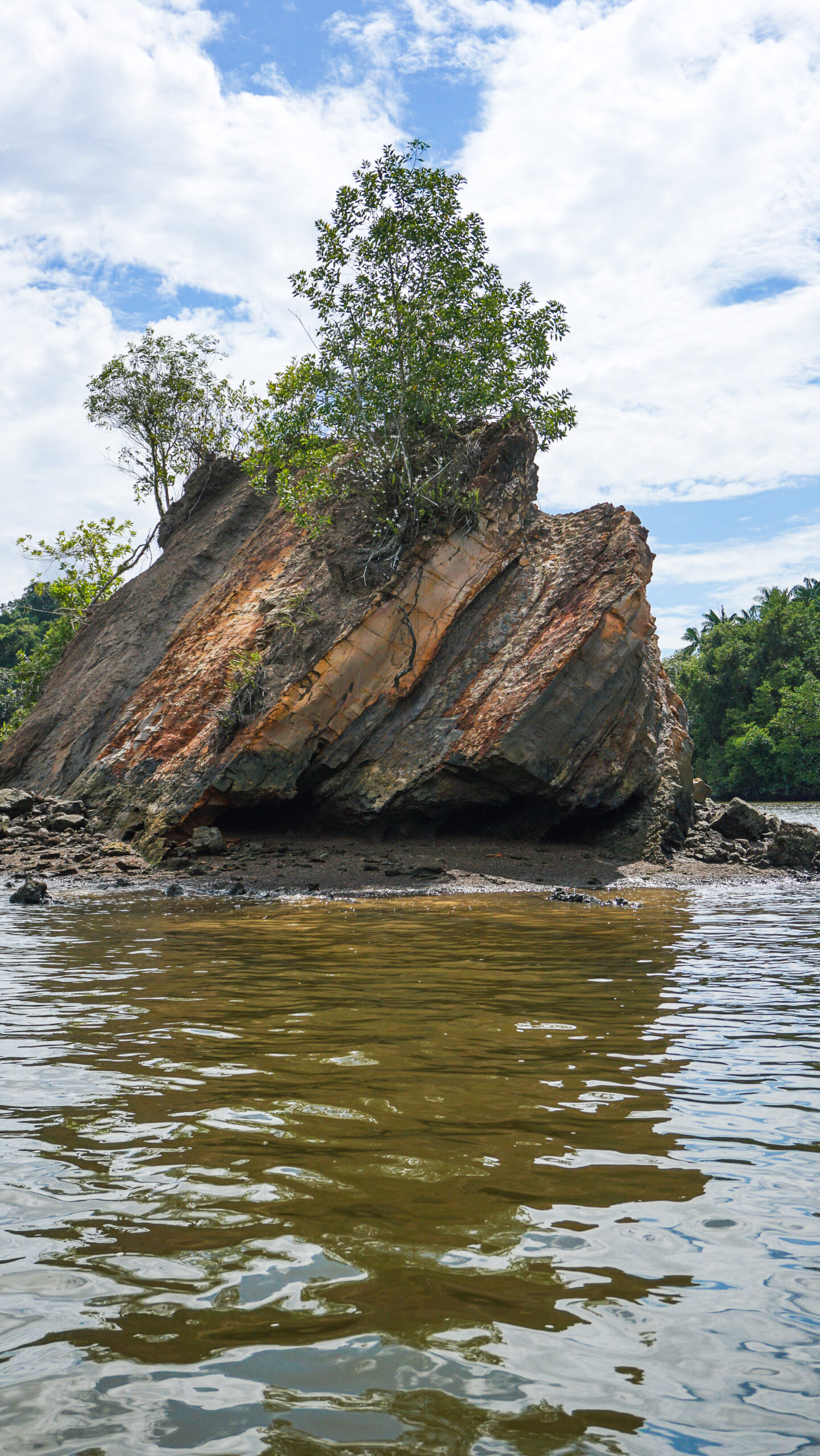by Jia Ying Chia
The island of Borneo to outsiders, and even those who call it home, is the stuff of legends; mythical stories of spirits, tribal wars and folklore of the past are rife across our land, painting a rich tapestry of the various cultures that inhabit a very different landscape. Come with us on a journey of our sacred sites and discover the land of unexpected treasures.
JONG BATU, BRUNEI
This misshapen rock in the south of the Brunei River may look like a mere rocky outcrop but at certain angles, it transforms into the bow of a sinking ship and the story of Nakhoda Manis and his doomed vessel. A restless young boy who lived with his wealthy windower mother, Dang Ambon, he longed for adventure outside his home of Kampong Ayer and set his heart on travelling to Sulok. Dang Ambon was heartbroken and pleaded him to stay. On his promise to return as soon as he had achieved his goals, Dang Ambon relented. Years passed and she had become poor, spending her fortune on charity in return for prayers of Nakhoda Manis’ safe return home.
One day, her prayers were answered nad news of her son’s return came. He has prospered on his journeys and had brought back his beautiful wife to meet his mother, who he had missed dearly. In her old and tattered boat, Dang Ambon rowed eagerly towards her son’s grandship but was dismissed by her new daughter-in-law who thought she was a filthy beggar. Although Nakhoda Manis instantly recognised his mother, in his embarrassment he denied her aboard and asked the crew to push her away.
Devastated, Dang Ambon cursed her son along and brought about a raging thunderstorm that turned the sunny sky black and caused a huge lightning bolt to strike and capsize Nakhoda Manis’ ship. When the sky cleared, onlookers were shocked as his sinking ship had turned to a giant rock that is now known as Jong Batu.
ALAI GAYOH, BRUNEI
While there is no wild, mystical legend behind it, the Alai Gayoh in Tutong is legendary in its own right. Culturally important to the Dusun tribe in Brunei, this house turned homestay was built in 2010 as an architectural replica of traditional Dusun homes. Alai Gayoh means ‘the large or great house’ and the shallow lake where the house was built has a history that stretches back two centuries.
According to Dusun elders, a fatal disease broke out in the area in the late 1800’s. A Dusun man named Yajung led two families including his own, to safety on the islet where the Alai Gayoh stands now. Living off the land and surrounding forest for more than two months, the structure has become a testament of the people’s resolve and a revered space for preserving Dusun culture. Village locals now refer to the site as Luagan Yajung.
PILONG ROCK AND LUMUT LUNTING, BRUNEI
The origin story of these islands has been passed down through the ages in the Syair Awang Semaun, a local folklore version of Awang Semaun’s epic poems. Back in the 14th century, Brunei played the role of a vassal state under the powerful Majapahit Empire. The first ruler of the new Brunei Sultanate, Awang Alak Betatar, had to pay an annual tribute of 40 ships filled to the brim with precious local camphor, to the King of Majapahit, Awang Senuai, a clever nephew of Awang Alak Betatar, owned a rooster that was unbeatable. He challenged Raden Angsuka Dewa, who owned a rooster called Asmara — said to be as valuable as a priceless gem for its magical powers.
The King of Majapahit declared that should he lose, the 40 ships laden with goods to Brunei; a win would result in the handover of more Bruneian territories. The whole town gathered at the Sultan’s palace to witness the battle — feathers flying and beaks peck-peck-pecking! Asmara was stabbed and as she attempted to fly away, she fell into the sea and instantly transformers into the majestic Pulau Pilong-Pilongan. Mutiara, while trying to chase Asmara, ended up being cursed and morphed into the rocky landmark of Lumut Lunting.
The elders of Kampong Ayer believe that Lumut Lunting will never be submerged, no matter how high the water rises. It became a sign of bad omens, like the passing of a king or some other unfortunate incident.
MOUNT KINABALU, KOTA KINABALU
Legend has it that a fierce dragon lived at the peak of the mountain, and owned a dazzling jewel that it loved to play with. People who lived nearby could see the gem sparkling as the dragon tossed it into the sky and caught it with its forked tongue. News of this jewel reached the emperor of China and determined to own it., he set his two sons on a journey to get it. His eldest son resigned with defeat after numerous attempts, whilst the younger one set about a plan to outsmart the dragon. Observing its habits, the young man made a colourful lantern that glowed as bright as the precious stone and a giant kite that would carry him.
When the dragon left its cave, he mounted the kite with the help of his men and launched himself towards the cafe. Switching the jewel and the lantern, he managed to make it back to his ship as the dragon realised what had happened. Giving chase, he caught and swallowed a scorching hot cannonball the prince’s ship had fired, thinking it was his treasured jewel. He sank into the sea writhing and bellowing with pain, never to be seen again. The name of Mouth Kinabalu is believed to come from the Kadazan term ‘Aki Nabalu’, which translates to ‘place of the revered dead’, and it is a widely held belief that spirits dwell at the top of the mountain.
MOUNT SANTUBONG, KUCHING
With a love triangle at the heart of the legend behind this landmark, you know there is a juicy story to be told! Legend has it that there were two princesses named Puteri Santubong (from the Iban term ‘spirit boat’) and Puteri Sejinjang who lived in the heavens and spent their days happily weaving beautiful clothes and making delicious ground rice.
The very best of friends, they became entangled in a desperate love triangle when the handsome and dashing prince, Putera Mahkota Serapi arrived. The two princesses battled it out to win his heart but despite this, the philandering Putera Mahkota couldn’t decide and offered to marry both women. This caused the two princesses to break into a violent battle with their working tools and they eventually killed one another. The King of the heavens was so furious that he cursed the two to become mountains and it is said that the mountain resembles a woman lying on her back.
Look a little closer and the reflection of Mount Santubong in the water may resemble that of the cursed Puteri Santubong herself! The surrounding islands of Kerak, lakir and Talang-Talang are rumoured to be shattered pieces of Puteri Sejinjang’s head while the rest of her lays nearby at Mount Sejinjang.










